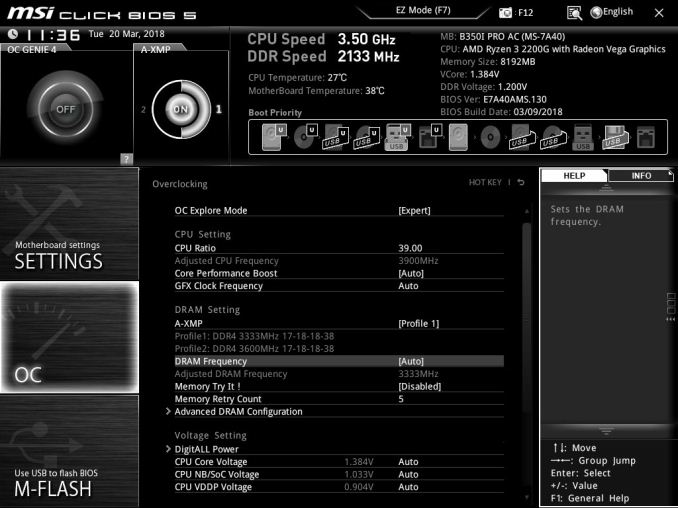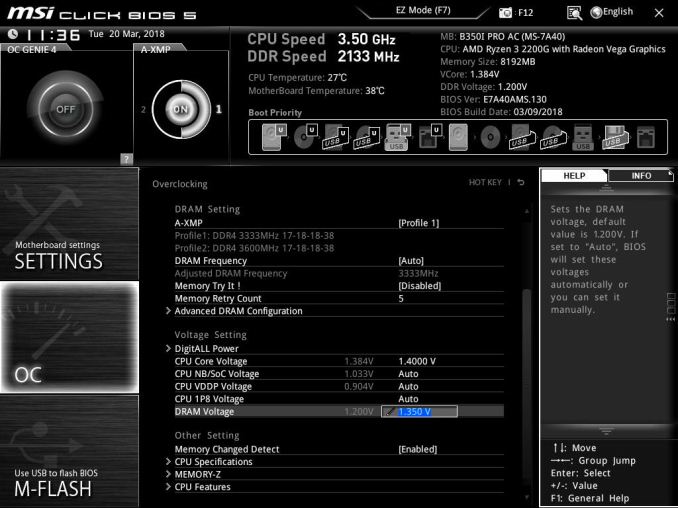AMD Ryzen 5 2400G and Ryzen 3 2200G Integrated Graphics Frequency Scaling
by Gavin Bonshor on September 28, 2018 12:30 PM EST- Posted in
- CPUs
- AMD
- GPUs
- Overclocking
- Zen
- APU
- Vega
- Ryzen
- Ryzen 3 2200G
- Ryzen 5 2400G
Overclocking Ryzen APU Integrated Graphics
As we detailed in our dedicated AMD Ryzen 2000 series APU overclocking guide and analysis, both the Ryzen 5 2400G and the Ryzen 3 2200G chips benefit from overclocking the CPU core frequency. The results on heavy computational workloads gave noticeable improvements across the board, while the gaming results didn't seem to have the expected 'oomph' so to speak. When it comes to overclocking the integrated graphics, the key directive and conclusion is that when a user is overclocking the CPU core frequency, it lessens the headroom available to overclock the integrated graphics and visa versa. It is a real push and pull situation.
Overclocking the integrated graphics on the MSI B350I Pro AC motherboard was quite easy as there are three main variables to consider.
- The graphics clock frequency is the primary frequency setting, measured in MHz
- The SoC voltage (or CPU NB Voltage) is directly linked to the integrated graphics voltage.
- The CPU core frequency and CPU core voltage can also help/hinder.
Beware the Black Hole!
When overclocking the integrated graphics core on both APUs, rising through the frequencies, we experienced an anomaly or 'black hole' between 1350 and 1500 MHz. Regardless of the settings, there was a clear issue in the system.
While the system would boot at these frequencies, the combination of overclock and drivers caused random reboots of the test system, constant and consistent crashes during gaming, and Windows Crash Reporter stating a 'Video_TDR_Failure' of the atikmpag.sys process. This error is usually an indication of a faulty or corrupt graphics driver, but in this instance, it happened across multiple systems with three different motherboards and operating systems using the AMD's Adrenalin Edition 18.5.1 WHQL drivers (the latest at the time of testing). The issue bestowed itself regardless of the GPU driver used, or BIOS revision on any of the motherboards tested.
At 1500 MHz however, the issue went away. Our experience is not unique - other professionals in the industry have experienced similar issues. We have reached out to AMD about this issue and will update when an official response is received.
Overclocking Results
The Ryzen 5 2400G has a base graphics frequency of 1250 MHz and the Ryzen 3 2200G has a base frequency of 1100 MHz. We were able to push both of them up to 1600 MHz, giving a 28% and 45% overclock respectively. For the completeness of data, we ran both APUs from 1100 MHz up to 1600 MHz, missing out the black hole. Here were our settings:
| Integrated Graphics Frequency | SoC/iGPU GFX Voltage |
| 1100 MHz | 1.15 V |
| 1150 MHz | 1.15 V |
| 1200 MHz | 1.15 V |
| 1250 MHz | 1.15 V |
| 1300 MHz | 1.15 V |
| 1350 MHz | 1.15 V |
| 1400 MHz | ERROR |
| 1450 MHz | ERROR |
| 1500 MHz | 1.20 V |
| 1550 MHz | 1.25 V |
| 1600 MHz | 1.25 V |












49 Comments
View All Comments
gavbon - Friday, September 28, 2018 - link
Yeah I do agree with you there, but the main purpose of an APU is to utilize the onboard graphics. Ok sure you lose bandwidth due to the limitation of PCIe lanes on them, but the specs have to be cut down somewhere and rather that than CPU or iGPU power.seamonkey79 - Friday, September 28, 2018 - link
By less than 1% in the vast majority of games. For PCIe 3.0/3.1, 8 lanes is still plenty for a card to the point where benchmarks are within the margin of error. That is until you start looking at SLI, on the level of (at least) GTX 1080 Ti or Titan V cards. At that point, you would be building a new system anyway because you'd need a board capable of handling 2 x16 slots, which you wouldn't have bought because a board with video outputs for the APU doesn't come with dual x16 slots. You're also buying a new CPU because you're not sticking $6k worth of hardware on a sub $200 CPU/chipset.https://www.gamersnexus.net/guides/2488-pci-e-3-x8...
https://www.gamersnexus.net/guides/3176-dual-titan...
In their testing, even on the Titan V, with a single card, there was no difference between x8 and x16.
So, no, you're not really in a situation where the APU will 'reduce performance', unless you're buying a sub-$200 CPU to stick in a system with around $6000 worth of dGPU. Which you can't do because you only have a single x8 slot anyway...
nathanddrews - Tuesday, October 2, 2018 - link
Correct, the only limitation is the 2200G/2400G itself (even at 4.1GHz), not the lanes. I've got a 1080Ti in my 3570K setup and I know full well when my CPU is the bottleneck.eva02langley - Saturday, September 29, 2018 - link
8x is performing basically the same for game performances. If you were to compute, that would be another story.It is actually a non-issue.
msroadkill612 - Wednesday, October 17, 2018 - link
Which is why its saddens me that the ~one true single ccx zen+ cpu - 2500x - is oem only.t.s - Friday, September 28, 2018 - link
Please fix: Civ. 6 graph are AVG FPS and AVG FPS, not AVG FPS and 99th %.Ryan Smith - Friday, September 28, 2018 - link
Whoops. Thanks for the heads up. Fixed!Valantar - Friday, September 28, 2018 - link
There are quite a few errors like this throughout the article. F1 for the 2200G are both 99th percentile. TW:W2 (same page) has the correct titles but same data in both images. There was more too, on earlier pages, but since I'm on my phone I can't look through it while writing this. Hope you can take a look.gavbon - Friday, September 28, 2018 - link
Thanks Valantar, fixed them now! Appreciate the heads up!ET - Friday, September 28, 2018 - link
My conclusion from this is that it's worth overclocking the 2200G to 1200 because the default clock performs badly in some cases.